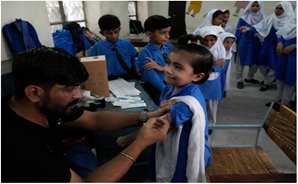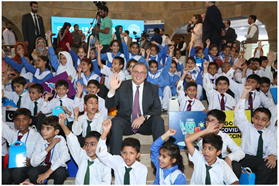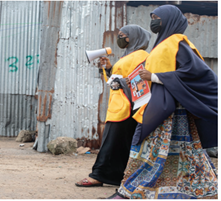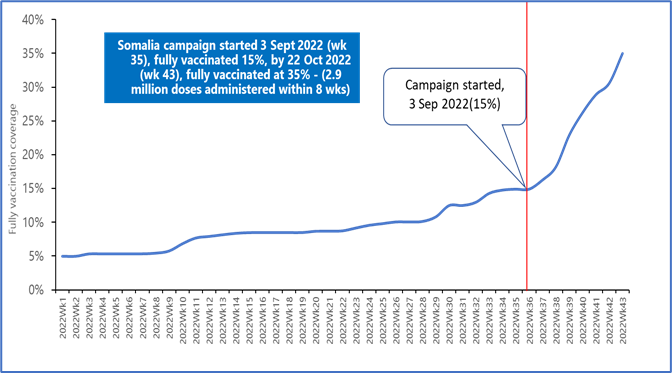Currently, 55% of the total population (744m, UNPD 2022 2021) received at least one dose of the COVID-19 jab. The fully vaccinated population is at 47% while the partially vaccinated at 8%. To continue boosting the population especially those at most risk, 16% are boosted in the region.
In this issue, we share the progress from 3 EMR countries between September and October 2022.


Photos: (Left) A schoolgirl receives the Pfizer- BioNTech COVID-19 vaccine at a school in Lahore on September 19, 2022. (Right) The US government representatives and Government of Pakistan health officials with vaccinated children with COVID-19 vaccine (Credit: WHO/EMRO)
Pakistan: A pediatric campaign was planned to reach children 5-11 years with COVID-19 vaccines. The first round planned for September (19 -24), 2022 reached more than 8 million children with coverage of 88% in two provinces (Sindh, Punjab) plus Islamabad. Planning was done by the highest governing body for COVID-19 response, the National Command and Operation Center (NCOC), including the Regulatory Authority. As part of Risk Communication and Community Engagement (RCCE), the education departments and the paediatric association conducted awareness efforts around the campaigns. An Adverse Events Following Immunization (AEFI) system was put in place that to ensure that a medical doctor is present in each vaccination session as a focal point. A hotline was created for the public to provide information, answer inquiries and for reporting any AEFI cases. The second round of the campaign took place in October 2022. The campaign is mainly supported by USAID.
Yemen: A round of integrated outreach vaccination was conducted in Yemen in September, aiming to vaccinate approximately ~500,000 persons with COVID-19 vaccines and children under 2 years of age with routine immunization vaccines. 1,500 mobile teams were deployed in 13 Governorates (114 districts) for one week. The targeted population for COVIDI-19 vaccination was 18 years and above, with special focus on elderly groups, pregnant persons, those with chronic health conditions, health workers, internally displaced persons, refugees and, students. 263,000 received the J&J vaccine, achieving a coverage of 57% of the set target for the campaign. In addition to the routine immunization and COVID-19 vaccines, the teams provided other health services like consultations on nutrition, integrated management of childhood illness (IMCI), reproductive health (RH), and medicine prescriptions.


Photos: (Left) Community awareness and mobilization in Somalia. (Right) Vaccination campaign in Somalia (Credit: WHO/EMRO)
Somalia: The country’s COVID-19 vaccination coverage was only 15% in the 35th week of 2022. By week 43, COVID-19 vaccination coverage more than doubled to 35%.
Somalia has set a national target to fully vaccinate 40% of its population by the end of December 2022. To achieve this, Somalia started a national phased campaign of COVID-19 vaccine roll-out on 3 September 2022 with a target of administering 3.5 M doses by the end of October 2022.
As of 22 October, 3.2 million people have been vaccinated with J&J, increasing coverage to 35%. This includes 2.4 million internally displaced persons (IDPs) and 370K nomads.
The success factors of the campaign were centred around strong political commitment at the national and regional levels, quality microplanning, training of vaccination teams, social mobilization and risk communication and community engagement activities.
Development of NIS in Djibouti, Lebanon and Yemen:
WHO is supporting EMR countries Djibouti, Lebanon and Yemen in the development of their National Immunization Strategy (NIS). Already, Djibouti and Lebanon have conducted a workshop to finalize their EPI situational analysis. A consultant was hired for Djibouti, and the country is at the final stages (costing using NIS.COST Tool) to finalize the NIS which will lead the budget dialogue. In Lebanon, the WHO Country Office is assisting in the development of a strategy framework and aims to use the NIS to rebuild and strengthen the country’s EPI after the latest socio-economic and political crises. In Yemen, two consultants; one international and one national are supporting NIS efforts.
